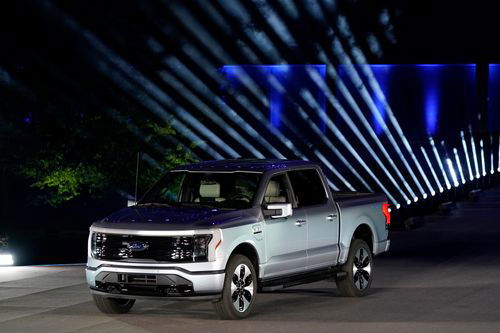Ford expects 40% of global sales to be electric vehicles by 2030

Ford is doubling down on electric vehicle development, announcing Wednesday it will invest $30 billion in electrification efforts by 2025. The automaker also pledged that 40% of its vehicles sold by 2030 will be electric.
Ford had previously announced plans to spend $22 billion on electrification efforts and had recently revealed plans to build two new battery factories in a joint venture with Korean battery maker SK innovation.
Last week, Ford also unveiled an all-electric version of the F-150 pickup, the best selling vehicle from any US automaker. The electric F-150 Lightning is due in showrooms in 2022. Ford said Wednesday that it received 70,000 customer reservations for the electric truck since it was unveiled a week ago. Ford has already started selling an electric SUV under its iconic Mustang name, the Mustang Mach-E.
But Ford is still playing catchup with all-electric vehicle maker Tesla and also with traditional automakers, such as its alliance partner Volkswagen and domestic rival General Motors. Both have more extensive EV offerings and more aggressive electrification targets. GM says it is aiming to sell only emission-free vehicles by 2035.
Ford said it is committed to catching and passing its rivals as the industry shifts to EVs.
“Our ambition is to lead the electric revolution. I really mean that,” said CEO Jim Farley, speaking to investors and analysts Wednesday. Asked about the GM target of being all electric by 2035, and whether Ford has a similar target date, Farley was somewhat dismissive of its rival’s promise, which GM CEO Mary Barra has described as an “aspiration” for the company.
“We’re talking about our entire fleet. No asterisk,” Farley said. “We think it’s prudent to focus not on an aspiration, but on our actual plans.”
Farley predicted that Ford will be able to capture equal or improved market share as it shifts to EVs. So far 70% of buyers of the Mustang Mach-E have come to Ford from other automakers, according to Lisa Drake, the chief operating officer of Ford’s North American unit.
Farley admitted that the company’s financial performance has not been as good as it should have been in recent years. Ford lost an average of $2 billion a year outside of North America in each of the last three years. But he pointed to the profit Ford posted overseas in the first quarter this year and said the company should now be able to achieve an 8% profit margin, excluding interest, taxes and special items, by 2023.
Virtually all automakers are ramping up production plans for electric vehicles to meet increasingly tougher environmental regulations and growing demand from car buyers. Electric cars have fewer moving parts than gas-powered vehicles, and therefore can be cheaper to build because they require less labor.
Farley forecast that costs of building EVs will fall as production increases, especially of EV batteries, a significant part of the price of building an electric vehicle. Farley predicted that battery costs will decline by 40% by the middle of this decade. So the shift to EVs will be able to “deliver higher profitability … compared to today’s ICE [internal combustion engine] offerings,” Farley said.
Investors are more interested in backing automakers with ambitious EV plans rather than traditional automakers. Tesla is by far the most valuable car company, despite having a fraction of the sales and profits of traditional automakers. Tesla’s market value is roughly equal to that of the value of the five largest global automakers combined.
Shares of Ford rose 7% in midday trading on its EV announcement, hitting a five-year high for its share price.